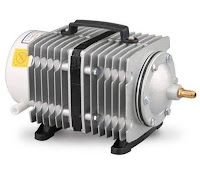• What are Air Pumps?
An air pump is one of the most basic, yet versatile, pieces of equipment that you will have to own for fish rearing, whether it is an aquarium or a fish farming tank. For biofloc fish farming, this is considered one of the most important equipment which you will need, so that you don't end up with thousands of dead fishes floating on the water surface. The basic function of an air pump is to force air, through mechanical means, from the atmosphere into your aquarium, which is later released inside the water in the form of bubbles.
Please note: This post contains Amazon Affiliate links. It would be highly appreciated if you please consider buying from the links provided. It won't cost you anything extra, but it may help us with a little bit of commission from Amazon.
• What is the use of air pumps in tanks?
Like we've discussed above, the air pump forces the air from the atmosphere into the tank through a pipe. The air is released through a air stone, this results in the creation of thousands of tiny air bubbles which rush to the water surface, causing surface agitation. This is beneficial in some ways:
- Increases the concentration of dissolved Oxygen (D.O.) in the tank.
- Fishes are constantly breathing oxygen and releasing carbon dioxide, these bubbles helps in releasing the dissolved carbon dioxide.
- Good aeration helps in stirring the water up to a certain degree. Maintaining proper water flow velocity is essential for optimizing biofloc systems and keeping microorganisms suspended in the water column.
- An additional benefit of aeration and mixing is the removal of gases from the water column, which can have a great effect on overall water quality.
• Types of air pumps :
- Electromagnetic air pump
- Diaphragm air pump
➤Electromagnetic air pumps are a type of rotary pumps where they rotor is constantly, well, rotating, and when it comes to fish-keeping trade, they generally look something like the picture attached. They are comparatively cheaper than diaphragm air pumps but they come with their own set of problems like:
➤Diaphragm air pumps are a better substitute for electromagnetic air pumps. They are a type of reciprocating pump, where the air is pumped in two-steps cycle. They can be comparatively quieter than electromagnetic air pumps, with lesser power consumption, and they last way longer in comparison. Even in case of malfunctioning, its usually a damaged diaphragm which can easily be replaced by a novice with just unscrewing about four screws and repairing it, that's why i always use them as my primary aeration source.
Please note: This post contains Amazon Affiliate links. It would be highly appreciated if you please consider buying from the links provided. It won't cost you anything extra, but it may help us with a little bit of commission from Amazon.
• How to choose the right pump for my tank?
Do consult your trainer under whom you were trained, he/she will probably assist you up to a certain extent, but do not follow him blindly. I mean, the person who trained us, said that any pump that causes "bubbles to come out of water" will be useful. He also insisted that any pump that pumps about 25 LPM (litres per minute) volume of air will suffice. That is not totally true. The depth of the tank affects the air pressure, and from my experience more is better, because its better use one pump for more than one tank, than using multiple pumps for them.
I use 120 LPM diaphragm pumps for two tanks (10,000 litres each) on an average, and they've been working fine for me. If you're going for just one tank in the beginning, try to invest just a little bit more and go for any pump that pumps 60 LPM volume of air or more, you can easily make 11-12 outlets from it and still have enough aeration and water movement.



























